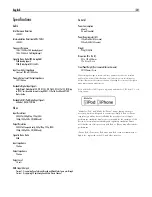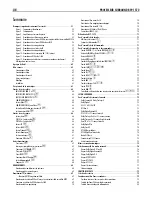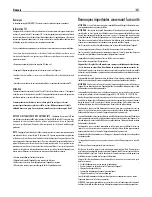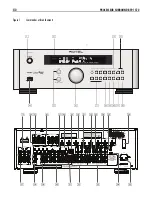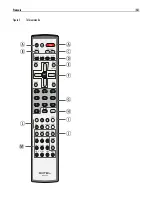
39
English
Speaker Setup
S P E A K E R
S E T U P
F R O N T : S m a l l
C E N T E R : S m a l l
S U R R O U N D : S m a l l
C E N T E R
B A C K : _ _ _ _ _ _
F R O N T
H E I G H T : S m a l l
S U B W O O F E R : Y e s
C - B A C K / F - H E I G H T : F R O N T
H E I G H T
A D V A N C E D : E n t e r
M A I N
M E N U
The SPEAKER SETUP menu is used to configure the RSP-1572 for use
with your specific loudspeakers and to determine the bass management
configuration as described in the previous overview. The menu is accessed
from the MAIN menu.
The following speaker options are available:
FRONT SPEAKERS (small/large):
Use the LARGE setting to have the front
speakers play low bass (full-range). Use the SMALL setting to redirect normal
bass away from these speakers to a subwoofer (high-pass filtered).
CENTER SPEAKER(S) (large/small/none):
Use the LARGE position (not
available with SMALL front speakers) to have the center speaker play
low bass (full-range). Use the SMALL position if your center channel
speaker has limited low frequency capability, or if you prefer that the
bass be sent to the subwoofer (high-pass). Select the NONE setting if your
system does not have a center channel speaker (the surround modes will
automatically divide all center channel information equally between the
two front speakers, creating a phantom center channel).
SURROUND SPEAKERS (large/small/none):
Select the LARGE setting (not
available with SMALL front speakers) to have the surround speakers play
low bass (full-range). If your rear speakers have limited bass capability
or if you would prefer that the bass go to a subwoofer, use the SMALL
setting (high-pass). If your system has no rear surround speakers, select
the NONE setting (surround channels are added to the front speakers
so none of the recording is lost).
CENTER BACK SPEAKER(S) (large1/large2/small1/small2/none):
Some
systems have one or two additional center back surround speakers.
Select the LARGE settings (not available with SMALL front speakers) to
have your center back speaker(s) play low bass. Use LARGE 1 if you
have one center back speaker (6.1) or LARGE 2 (7.1) if you have two
center back speakers (7.1). If your center back speakers have limited bass
capability or if you would prefer that the bass go to a subwoofer, use the
SMALL setting (SMALL1 for one speaker, SMALL2 for two speakers). If
your system has no center back speakers, select the NONE setting. With
center back speakers, the Rotel XS eXtended surround, Dolby Digital EX,
DTS-ES, Dolby Pro Logic II, DTS Neo:6 or other decoders will provide
center back signals for any surround mode.
FRONT HEIGHT (large/small/none:)
Use this setting if you have Front
Vertical Height speakers installed in a Pro Logic IIz setup.
SUBWOOFER (yes/no/max):
The YES setting is the standard setting if
your system has a subwoofer. If your system does not have a subwoofer,
select NO. Select the MAX setting for maximum bass output with normal
bass being duplicated by both the subwoofer and any LARGE speakers
in the system.
C-BACK/F-HEIGHT:
Select CENTER BACK if you have center back
speakers installed, or FRONT HEIGHT if you have vertical height speakers
installed.
ADVANCED:
Speaker configuration is generally a global setting for all
surround modes and need only be done once. However, for special
circumstances, the processor provides the option of setting the speaker
configuration independently for each of four surround modes. Select the
ADVANCED line on the menu and press ENT to go to the ADVANCED
SPEAKER SETUP menu described in the following section.
To change a setting on the SPEAKER SETUP menu, place the highlight
on the desired line using the Up/Down buttons and use the Left/Right
buttons to toggle through the available settings. To return to the MAIN
menu, press the ENT button. Press the RCVR/SETUP button on the remote
to cancel the display and return to normal operation.
Advanced Speaker Setup
A D V
S P E A K E R
S E T U P
S P E A K E R : F r o n t
C R O S S O V E R : 1 0 0 H z
D O L B Y : S m a l l
D T S : S m a l l
S T E R E O : L a r g e
D S P : S m a l l
S P E A K E R
S E T U P
M E N U
In most cases, the standard speaker configuration described above is
a global setting and can be used for all surround modes. However, the
processor provides the capability to customize these settings for four
different surround modes: Dolby, DTS, Stereo, and DSP. For example,
you could set up the Dolby and DTS modes for 5.1 channel sound,
while the Stereo mode changes to a 2-speaker setup with or without a
subwoofer. In addition, the ADVANCED SPEAKER SETUP allows you to
select a customized high-pass crossover frequency for the front, center,
surround, and surround back speakers.
Note:
In most systems, the default settings on this menu will provide
the most predictable results and most users will not need to change any
settings. You should fully understand bass management and have a
specific reason for needing a custom configuration before changing these
settings. Otherwise, skip to the following topic, SUBWOOFER SETUP.
The available settings on the ADVANCED SPEAKER SETUP menu are
as follows:
SPEAKER (front/center/surround/center back/subwoofer):
Select the
set of speakers to be configured with custom settings.
CROSSOVER (40Hz/50Hz/60Hz/70Hz/80Hz/100Hz/120Hz/150Hz/
200Hz/OFF):
Typically, the RSP-1572 uses a single master setting for the
high-pass and low-pass crossover point between all SMALL speakers and
the subwoofer. This master crossover point is set on the SUBWOOFER
SETUP menu described in the following section. When you first access the
ADVANCED SPEAKER SETUP menu, the current master crossover point
will be shown on this line. Change the value of this line only if you want
the current speaker to have a different crossover point. For example, if
your master crossover is set to 80Hz, but you want your front speakers
to crossover to the subwoofer at 60Hz, you would select 60Hz for the
front speakers on this line. This setting ONLY affects redirected bass and























